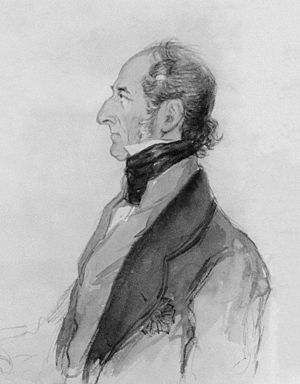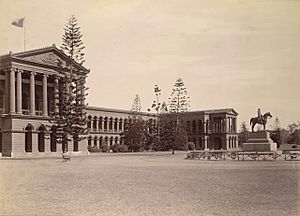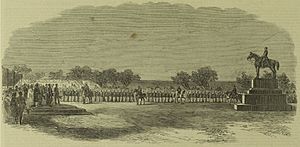Mark Cubbon (army officer) facts for kids
Quick facts for kids
Sir Mark Cubbon
|
|||||
|---|---|---|---|---|---|
 |
|||||
| Born | 23 August 1775 Maughold, Isle of Man |
||||
| Died | 23 April 1861 (aged 85) Suez, Egypt |
||||
| Allegiance | United Kingdom of Great Britain and Ireland | ||||
| Service/ |
Honourable East India Company | ||||
| Years of service | 1801–61 | ||||
| Rank | Lieutenant-General by Brevet | ||||
|
|||||
Sir Mark Cubbon (born August 23, 1775 – died April 23, 1861) was a British army officer. He worked for the Honourable East India Company, a powerful trading company that also governed parts of India. From 1834 to 1861, he served as the Chief Commissioner of Mysore, a large kingdom in India.
During his time in charge, Sir Mark Cubbon made many important changes. He improved law and order, introduced new laws, and helped the economy grow. His leadership kept Mysore peaceful during the Indian Rebellion of 1857, a major uprising against British rule. He resigned in 1860 due to poor health and passed away in 1861 while traveling. Today, places like Cubbon Road and Cubbon Park in Bangalore are named after him.
Contents
Early Life and Education
Mark Cubbon was born on August 23, 1775, in Maughold, a village on the Isle of Man. He was one of ten children. His father was Vicar Thomas Cubbon, and his mother, Margaret Wilks, was the sister of Colonel Mark Wilks.
As a child, Mark enjoyed exploring the hills around his home. He went to the local parish school and later studied with a tutor named Maddrell. His uncle, Mark Wilks, helped him get a cadet position in India in 1802.
Early Career in India
Cubbon arrived in Calcutta, India, in 1801. He joined the 2nd Madras Battalion in 1802. Later, he moved to the 2nd Battalion 5th Native Infantry in 1804. He served in Travancore, working under Colonel John Chalmers.
Cubbon greatly respected the Sepoys, who were Indian soldiers serving the British. He admired their religious beliefs. In 1809, he received a civil job. However, he lost this job because he refused to sign a new declaration from the governor of Madras. This event was part of what was called the "white mutiny."
He was reappointed in 1810 to the Commissariat Department. This department was in charge of supplying the army. He worked under Colonel Close and later Colonel Philip Meadows Taylor. A year later, he became an Assistant Commissary-General. This was a very high position for someone of his rank. He became a Major in 1823 and a Lieutenant-Colonel in 1826. In 1827, he moved south to work as Commissary-General in Travancore.
Leading Mysore
After Tipu Sultan died in 1799, the British brought back the old Hindu royal family to rule Mysore. A young prince was put in charge, with a minister named Purnaiah helping him. However, the way taxes were collected became unfair, and there was a lot of corruption.
This led to an uprising called the Nagar revolt in 1831. The prince could not control it. The British helped put down the rebellion. A group was formed to find out why the uprising happened. This group, which included Cubbon, reported that the kingdom was being very badly managed.
Because of this, the Governor-General of India, Lord William Bentinck, decided that the British would directly rule Mysore. At first, two Commissioners were appointed, but they argued. So, in May 1834, William Morrison became the sole Commissioner. When he was transferred, Mark Cubbon took over as Commissioner in June 1834.
Improving Law and Order
When Cubbon took over Mysore in 1831, his first goal was to establish law and order. At that time, murders to settle arguments were common in towns and villages. Cubbon was very concerned by how accepted this seemed to be.
He improved the system of "Silladars," who were local horsemen serving the government. He increased their pay to prevent them from taking bribes. He created a force of about 4,000 horsemen in seven groups. Each local area had a detachment of these horsemen.
Before July 1834, there was no police force. Cubbon created a police code called a "hukumnama." This separated the local police from the military. The police had armed and unarmed sections.
- The armed police dealt with prisoners and helped in the field. They also hunted tigers, receiving a reward for each one. They guarded important places and prevented thefts.
- The unarmed police, called khalihaths, helped repair roads and irrigation systems. They also followed other orders.
Cubbon set up a reporting system mostly run by Indian officials.
New Laws and Justice
In 1834, Mysore did not have a clear set of laws. Cubbon used and expanded a system described by his uncle, Wilks, in 1804. Cubbon created a new justice system that became very popular. He made himself the highest authority for serious crimes. Sometimes, he even changed court decisions.
Using the same laws for everyone, no matter their social class, was new in Mysore. Cubbon also reduced the power of "poligars," who were local chiefs. They were given a pension instead of their old powers. Cubbon also helped solve arguments between different religious and caste groups by using majority votes.
Government Structure and Money
Cubbon made the government very strict and organized. He fired officials who took bribes. He also dismissed a court officer who held extreme religious views.
He set up nine main government departments, called "kacheris":
- Revenue (collecting taxes)
- Posts (mail service)
- Police (maintaining order)
- Public Works (building and repairs)
- Military (army matters)
- Medical (healthcare)
- Public Cattle (managing livestock like the Amrit Mahal)
- Judiciary (justice system)
- Public Instruction (education)
Before Cubbon, government papers were written in many languages, which caused problems. Cubbon decided that only Kannada and Marathi should be used.
He also made strict rules for keeping track of all money collected and spent. He used the local currency, the Kantarayi pagoda, for public accounts. This system was used until 1854, when it was replaced by the East India Company's currency.
Social Improvements
Cubbon supported schools, especially those run by missionaries. He also worked on healthcare, setting up hospitals and homes for people with leprosy. He made rules against different forms of slavery that were common in parts of Mysore. All kinds of forced labor and torture were made illegal. He also improved prisons and used prisoners to help with public works projects.
During the 1857 rebellion, Mysore remained peaceful because of Cubbon's good governance. A small group in Srirangapatna planned a rebellion, but Cubbon secretly stopped it with the help of warriors from Coorg. As a reward, the Coorg people were allowed to keep their weapons when others had to give theirs up.
Farming and Roads
Farming had suffered a lot due to chaos and unfair practices by money lenders. Cubbon worked to improve irrigation systems. He supported projects like the Marikanive project and work on several rivers.
In 1839, he started the agri-horticultural society. He also transferred the Lalbagh gardens to this society. He believed this would help farmers by introducing new crops like better sugar-cane, cotton, and tobacco. He also wanted to teach people improved farming methods.
Cubbon introduced new crops and livestock breeds. He also cared about forests. He started sisoo plantations in 1846 and teak plantations in 1855-56. He made it illegal to cut valuable trees without government permission. He also banned "kumri," a method of farming where forests are cut and burned.
He also improved the road system, creating four classes of roads. He oversaw the building of bridges at important places. He opened up new passes through the Western Ghats mountains to make travel easier.
Cubbon also supported traditional religious institutions. He gave special help to temples, monasteries, and old age homes that the maharaja had supported.
Cubbon's Leadership Style
Cubbon used many local Indian people in his administration. This reduced the need for European officials. From 1834, he was the only Commissioner for Mysore. In 1836, he also took charge of Coorg. From 1843, he acted as the Resident for Mysore without extra pay. Cubbon's administration was very cost-effective, needing only about four Europeans and costing around £13,000 a year.
He was knighted as a Knight Commander of the Order of the Bath (K.C.B.) in 1856.
In 1859, there was a plan to move Mysore's affairs from the Governor-General to the Madras government. Cubbon disagreed and resigned. The Viceroy, Lord Canning, then withdrew the order. However, Cubbon had to resign again the next year due to his poor health.
Supporting Kannada Language
Mark Cubbon showed special interest in the Kannada language. He gave money to help publish the first Kannada translation of the Bhagavad Gita in 1849. This book had Sanskrit, Kannada, and English versions side-by-side.
He also supported the printing of the first Kannada-English dictionary. This dictionary was put together by William Reeve and published in 1858.
Personality and Home
Cubbon lived in India for a long time and deeply understood the local people and their traditions. He was known for being fair and tactful. He avoided using spies to get information, which was common at the time.
He had to host formal dinners for his job but did not enjoy parties or dancing. He loved horses and kept many in his stables. He did not go to church himself, but he made sure all government offices were closed on Sundays. Cubbon never married.
In 1834, Cubbon built a summer home on top of Nandidroog. Lady Canning, a visitor, described it as a "charming old General" and a "very pleasant spot." She noted that Cubbon, despite being in India for a long time, seemed to know everything happening worldwide.
Death and Legacy

Sir Mark Cubbon passed away on April 23, 1861, in Suez, Egypt. He was on a ship returning to England with his doctor. He died from a liver problem or possibly a lung infection. His last words were "And through no merit of my own."
His body was taken to the Isle of Man and buried in Maughold Churchyard on May 17. Many people attended, and the Archdeacon said, "In that vault lies the greatest man this island has produced for centuries back." When news of his death reached Mysore, all public offices closed for three days.
A statue of Sir Mark Cubbon on horseback, made by Baron Marochetti, was unveiled on March 16, 1866. It was first placed in a parade ground in Bangalore. Later, it was moved in front of the main government buildings, which now house the Karnataka High Court.
Cubbon Road, Cubbonpet, and Cubbon Park in Bangalore are all named after him. A portrait of Cubbon can also be seen on the ceiling of the Karnataka High Court building.
After India gained independence in 1947, Cubbon's statue was largely ignored. However, on August 23, 2013, his 238th birthday was celebrated, and his statue was garlanded for the first time. This event needed special permission and police protection. Some people, like Vatal Nagaraj, felt that British statues should be moved to museums. On June 28, 2020, the statue was moved from the High Court to Cubbon Park.
See also
- Administration of the Kingdom of Mysore




